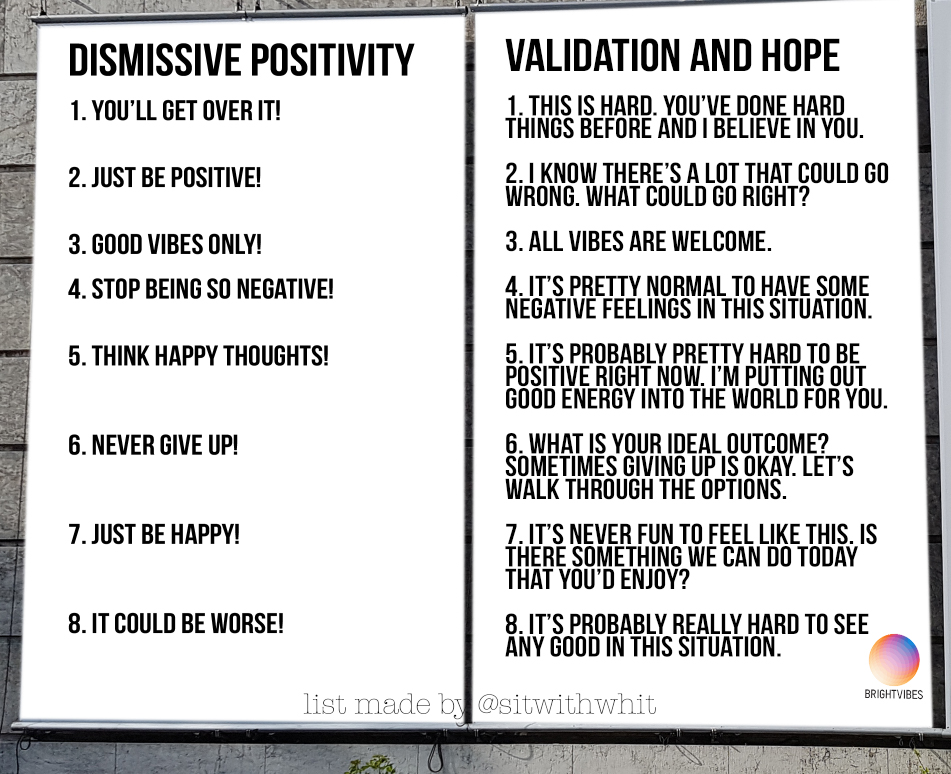
- Inspiring People -
- 4mins -
- 1,585 views
This helpful chart explains the difference between support and dismissive positivity
When people seek help and support, they’re usually not asking for trite, inspirational poster positivity. More often than not they’re looking for validation that their negative feelings are OK.
Validation and hope versus dismissive “toxic” positivity
There’s no doubt that positivity can be powerful tool. When struggling with anxiety and negative thoughts, if you can hold onto any glimmer of hope—that you’ll make it through, that you’re not defined by these thoughts, and that you’re not as bad as your brain is making you out to be—the chances are you’ll cope a little better. The positivity we hold within ourselves, when we can manage it, makes it a little easier to get by. However, and somewhat counterintuitively, positivity isn’t always the best way to help others. This helpful chart is a good guidance for what (and what not) to say.

While you can’t make someone be positive, you can mitigate the negativity with well-chosen words
You can’t make someone be positive. You can’t simply sprinkle positivity powder on them and make their problems go away. In truth, when people are seeking help and support, they’re usually not looking for trite, inspirational poster positivity. More often than not, they’re looking for validation that their negative feelings are OK.
The above graphic, made by Whitney Hawkins Goodman, LMFT, owner of The Collaborative Counseling Center, explains “Toxic Positivity”, and once you know what it is you’ll begin seeing it all over social media.
The graphic shows the difference between supporting someone with validation and hope, and trying to support them with “toxic positivity.”
According to Whitney, it’s the difference between, “This is hard… I believe in you,” and, “Just be happy!”
If you could never pinpoint why simple “inspiring” quotes didn’t sit well with you, this could well be the reason.
Source: Good.is
Supporting people is less about being “positive” and more about validation of their feelings
Naturally, when we spout phrases like, “Think positive,” or, “Stop being so negative,” we’re no doubt coming from a good place. We mean well.
We’re spreading these messages because we want people to be happier, surely? So what’s wrong with reminding people to be positive?
Well, the fact of the matter is this: supporting people isn’t about being “positive.” In fact, when you force positivity upon someone, it can actually have the opposite effect.
“Toxic positivity” can make people feel unsafe about expressing their negativity, and negativity thrives in isolation.
It can make people think there’s something wrong with them for not simply “choosing” happiness, and shame is negativity’s enabling best friend.
When supporting someone who is feeling low, we need to leave room for positivity to grow. You wouldn’t shout at a flower to “just” grow — you water and nurture it. In this instance, you water it with listening, with validation, and with unconditional support.
It’s OK to experience negative emotions, and with support, we can help people who are stuck in negativity find their own way out. Simply telling them to “be positive” doesn’t work.
In his fantastic book, The Antidote: Happiness for People Who Can’t Stand Positive Thinking, journalist and author Oliver Burkeman notes that “our constant efforts to eliminate the negative… is what causes us to feel so insecure, anxious, uncertain, or unhappy,” and advocates instead the embrace of a ‘negative’ approach to happiness.
Thanks to Whitney Hawkins for making this helpful and informative graphic! You can follow her on Instagram here.
(Adapted from an article for Good.is, by Sarah Schuster)
How to help yourself when caught in a negative thought spiral
- Acknowledge the thought (trap it). When you hear that same old broken-record thought again (“I’ll never make the right decision”; “I don’t do well in situations like this”), rather than follow it down the rabbit hole, trap it: Be aware of the role that the thought is playing, almost as if it were separate from you.
- Seek out the source (map it). When’s the last time you heard this thought or felt sucked into this downward spiral? What’s causing it now? When you can identify that as a symptom rather than a flaw, you can keep it from getting you into a stranglehold.
- Accept and move on (zap it). Whether you call it acceptance or the negative path or whatever, the key is to recognise that this thought is not who you are. A thought alone can’t doom you to failure.
- Let your values, not your thoughts, drive. You need to get bigger than the battle between negative and positive, and the way to do that is by remembering what drives you, what matters most.
Source: Forbes

